Alaska Fish & Wildlife News
August 2025
Mountain Goats in Alaska
Why sex matters
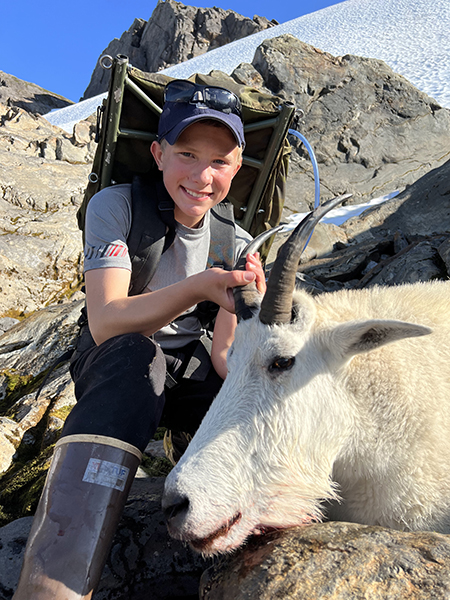
Hunters should be able to tell the difference between male and female mountain goats. If they can, and they target billy goats instead of nannies, goat numbers will likely grow.
That’s the reason for the new requirement that anyone hunting mountain goats in Alaska must pass the Mountain Goat Identification Quiz prior to hunting. This has already been required in some of Alaska’s game management units but now applies to all goat hunts. Fish and Game provides excellent materials to help hunters pass the quiz.
Mountain goats are unique to western North America and are found only in a few western states and Canadian provinces. They are truly well named, and their steep, alpine homes subject them to avalanches, rockfalls, extreme weather and potentially brutal winters. They are not prolific (relative to other big game animals such as deer) and hunted populations require attentive wildlife management. Their low reproductive rate means harvesting nannies can significantly reduce population productivity, leading to early hunt closures and more restrictive regulations.
Wildlife Biologist Roy Churchwell said when deer populations crash, they can recover in three to five years under usual Alaska conditions. A female Sitka black-tailed deer starts breeding at three years old, breeds every year, and typically has twins.
“Goat populations aren’t that way,” he said. “A female goat doesn’t start breeding until she’s five years old, and a lot of females are having a kid only every other year or so.”
A lifespan of 10 or 12 years is typical for adults of both species. A nanny may have three or four kids in her life, while a doe may have closer to 20 fawns.
It might seem that a simple solution would be to require that hunters only harvest billy goats. But consider goat hunting – goats inhabit open country above treeline and are wary and alert. While it’s easy to spot and watch them from a distance, it’s very difficult to get close. They’re often in mixed-age groups, and both billies and nannies have horns. While adult billies are bigger than nannies, around 250 pounds, both are stocky, muscular animals and relative size differences may not be apparent.
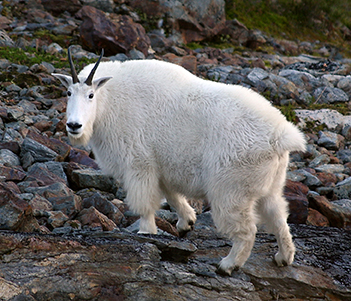
As a result, either sex harvest is reluctantly allowed. This is true in other states such as Oregon, Washington, and Idaho - which also have billy/nanny identification requirements for hunters. The differences between billies and nannies are subtle to a casual observer, but the identification guides highlight distinctions and behaviors that enable hunting guides and serious hunters to consistently recognize billies. The key is watching goats using a spotting scope and taking the time to spot the “tells.”
Wildlife Biologist Charlotte Westing manages a productive and popular goat hunting area around Prince William Sound. Although harvesting nannies does have a biological impact, educating hunters is preferable to outlawing it.
“We don’t want to make people criminals,” Westing said. “We want people to learn and think, to take their time and do their best.”
People make honest mistakes, Churchwell said, and biologists who manage goat hunts don’t want to discourage or penalize hunters from reporting their harvest. He noted that guided hunters have significantly lower nanny harvests, because guides are good at identifying billies and those guided hunters, often nonresidents, really want a billy.
The Hunt of a Lifetime
In Pacific Northwest states mountain goat hunting is a once in a lifetime experience. In Oregon, fewer than 25 tags are available for the annual draw, and a person may draw only one mountain goat tag in a lifetime. That’s just the opportunity to hunt. In Washington state, only seven goat tags are available this year and a hunter may harvest only one goat in a lifetime.
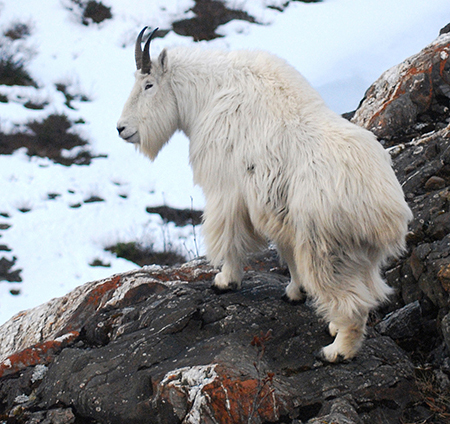
Alaska offers unparalleled opportunity to hunt goats – and that hinges on careful, sustainable management. In 2024, 715 mountain goats were harvested in Alaska, by about 470 resident hunters and 250 nonresident hunters. Hunters may register for more than one hunt, and often hunters don’t go.
“People plan to go then don’t,” Churchwell said. “That happens with all kinds of hunting, but that’s most common with goats. The strenuousness of the hunt and the impact of weather determines whether they go or not. Not only are you discouraged from climbing up a mountain in fog and rain you may not even be able to see the goats when you get there.”
Much of Alaska’s big game harvest occurs in general season hunts, but there are no general season goat hunts in Alaska. About 50 goat hunts in Alaska are registration hunts, which are more closely monitored. Generally, registration hunts do not limit the number of permits (about 40 goat hunts are drawing permit hunts - a lottery-style system which does limit the number of hunters). Biologists determine how many animals may be harvested, and hunters report when they are successful. If the maximum allowable harvest is reached, the season can be closed early by emergency order.
Several strategies help biologists provide hunting opportunities and maintain sustainable goat populations. Many use a point system for an area; a certain number of points are established as a harvest quota and males = 1, females = 2. When the quota is met for an area, hunting is closed. So, for an area with six points, that’s six billies, or something like one nanny and four billies. Biologist Charlotte Westing likens that to, “a whole other goat that someone else can’t take.”
Balancing Opportunity and Sustainability
Westing manages GMU 6 - the steep coastal terrain around Prince William Sound and the Chugach Mountains overlooking the northern Gulf of Alaska. It’s home to an estimated 3,500 to 4,000 mountain goats. In 2024, almost 600 permits were issued and 225 people hunted; 102 goats were harvested and 80 were billies.
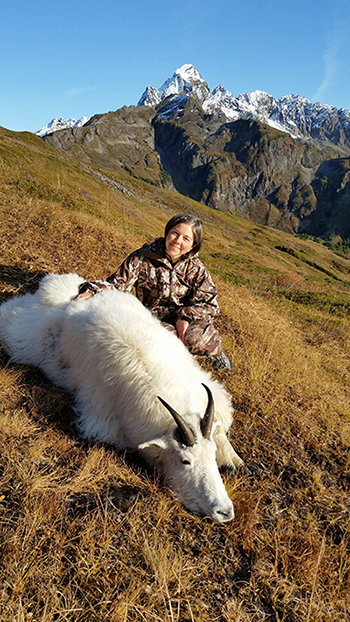
The area is managed as 17 different registration hunts. The size and accessibility of each area varies, as does the goat populations, and they have different management challenges.
“Some hunts you can drive to,” Westing said. “Some are very hard to get to, fly-in only. Some are very popular, and we’re seeing growing interest and participation. Many are open for only a few weeks, because they have good access. There are budget DIY hunts, a couple of buddies can get a weather window and motor over in a boat or drive to a trailhead and go. There’s also a commercial presence (guided hunts), and they are popular with nonresidents.”
Each hunt has a separate harvest quota, some as few as five points, others as many as 22. In 2023, about half the hunt areas were closed when the maximum allowable harvest was reached. Some never close because the quota is not reached.
Westing carefully tracks the harvest in each area. Successful hunters must report their harvest in three days in some areas, and five in others, depending on the hunting effort in the area and its history. In popular areas that are prone to going over, she may announce a closure when they hit 75% of points available, she said. In areas that rarely or never close, she may keep the area open until the regular end of the season.
“I take into account: have we gone over in the past and by how much? How much longer is the season? What is the hunting effort like in that area? What’s the weather doing?”
In some units, wildlife managers use another tool to discourage hunters from taking nannies; a hunter who takes a nanny cannot hunt in the area again for five years.
“The regulation was put in place because there were people here that would hunt goats every year and were indiscriminate with what they took,” Westing said. “It has probably reduced the habitual or indiscriminate hunters.”
One and done
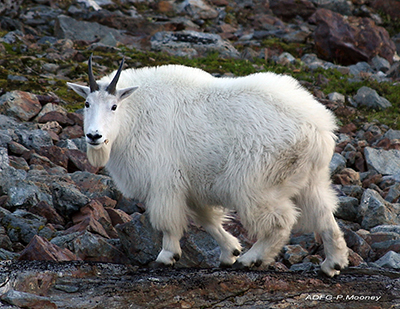
Wildlife Biologist Steve Bethune is based in Sitka and manages hunting on Baranof Island. In 2024, 205 hunters registered and 83 hunted, harvesting 29 billies and six nannies. The quiz requirement is already in place in his area and hunters are familiar with the requirement. Bethune manages the area as 34 zones. Depending on the zone, between two and six goats may be harvested – but only one nanny.
“I don’t manage by points, it’s a one-and-done thing,” he said. “If somebody shoots a nanny, the zone is closed. If everyone does their part and shoots only billies, they get six billies, or four, whatever the zone quota is. People can still go hunting, they just have to pick another spot.”
As Westing points out, hunter access is a major factor in goat hunt management, and that’s also behind Bethune’s strategy with the zones. Previously, the quota for a large zone could be reached after several goats were taken from a small area around a single access point, which resulted in the entire area being closed while additional harvest opportunity remained in more remote portions.
Goat ID and the Quiz
The Mountain Goat Identification Quiz is available online and consists of 26 questions. Hunters must answer 21 questions correctly to pass the quiz. Hunters that have previously taken the quiz and have proof of completion do not need to take it again, and hunters do not need to take the quiz annually. Hunters that have misplaced their completion card are encouraged to take the quiz again to refresh their memory and to obtain another card.
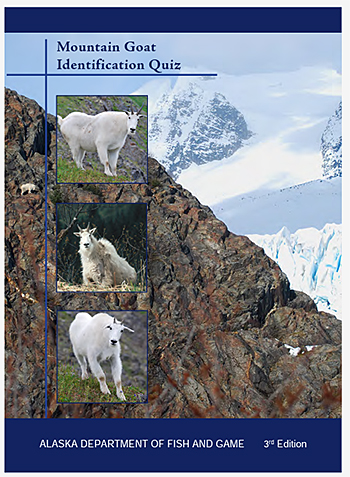
All goat hunters must carry proof of passing the quiz while hunting, as well as their hunting license, permit, and locking tag if applicable,
For questions about mountain goat hunting opportunities or completing the quiz, please contact the ADFG office closest to your planned hunt area.
More Wildlife Identification Quizzes
Mountain goat harvest statistics
More information is available regarding specific goat hunts by contacting area offices:
Douglas Office: 907-465-4265
Sitka Office: 907-747-5449
Petersburg Office: 907-772-3801
Ketchikan Office: 907-225-2475
Cordova: 907-424-3215
Kodiak: 907-486-1880
Soldotna/Homer (Kenai Peninsula) 907-260-2950
Subscribe to be notified about new issues
Receive a monthly notice about new issues and articles.
